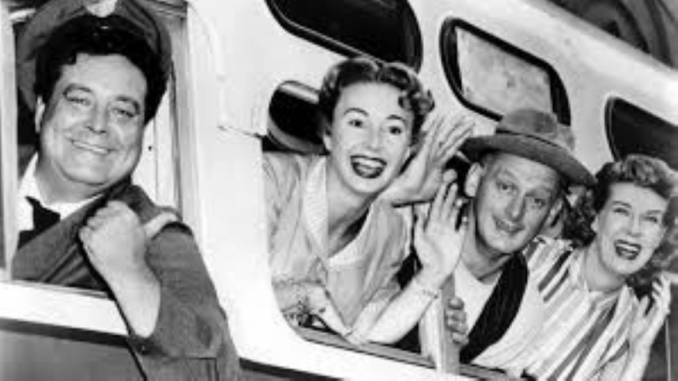
When The Honeymooners premiered in 1955, few could have predicted that its single season of 39 episodes — now famously called the “Classic 39” — would ripple across decades of television history. Though brief, the show set a standard for situational comedy, blending relatable struggles with sharp humor, and became a blueprint for countless sitcoms that followed.
At the heart of The Honeymooners was its unflinching look at working-class life. While other 1950s sitcoms, such as Father Knows Best or Leave It to Beaver, often painted idealized pictures of suburban families, Jackie Gleason’s show grounded itself in the reality of city living. Ralph Kramden, a perpetually scheming bus driver, and Ed Norton, his sewer-working sidekick, weren’t polished professionals. They were dreamers scraping by, trying to turn small paychecks into big ambitions. Their frustrations — money problems, broken appliances, dashed hopes — mirrored those of millions of Americans. Audiences connected deeply because, finally, television was holding up a mirror to their own daily struggles.
That relatability proved fertile ground for influence. Hanna-Barbera’s The Flintstones is perhaps the most direct heir, often dubbed “the animated Honeymooners.” Fred Flintstone and Barney Rubble’s dynamic is nearly identical to Ralph and Norton’s, while Wilma and Betty play the grounding roles Alice and Trixie perfected. The resemblance was so strong that Gleason reportedly considered legal action, though he ultimately refrained — possibly out of fear of being remembered as the man who killed America’s favorite cartoon caveman.
But the show’s reach extended far beyond animation. In the 1970s, All in the Family carried forward the template of domestic sparring, with Archie and Edith Bunker echoing Ralph and Alice’s verbal jousts. Later, Roseanne would reimagine the formula for the late 20th century, placing a sharp-tongued wife and her flawed but loving husband at the center of working-class comedy.
Structurally, The Honeymooners also pioneered the idea of a four-person ensemble. With Ralph and Alice Kramden paired alongside Ed and Trixie Norton, the show created a tight, recurring unit of characters. This format gave audiences consistency while allowing writers to explore storylines rooted in the relationships between two couples. The model proved so effective that it influenced everything from I Love Lucy to Friends and beyond.
Even into the late 1990s and early 2000s, the DNA of The Honeymooners remained visible. In The King of Queens, Kevin James’ Doug Heffernan is essentially a modern Ralph Kramden — a blue-collar everyman with big ideas, a sharp-tongued wife, and a loyal but quirky sidekick in Jerry Stiller’s Arthur. The echoes are undeniable.
What makes The Honeymooners remarkable is that its impact far outweighed its lifespan. With just one season, it proved that sitcoms didn’t need polished perfection to resonate. They needed authenticity — flawed characters, real struggles, and laughter drawn from the challenges of everyday life.
Nearly seven decades later, the show’s influence remains unmistakable. Whenever audiences laugh at a bickering couple who clearly love each other despite the arguments, or at a hapless dreamer with schemes too big for his paycheck, they are, in some small way, laughing with Ralph and Alice Kramden.
In television’s vast history, The Honeymooners stands as proof that sometimes a single season is all it takes to change everything.
